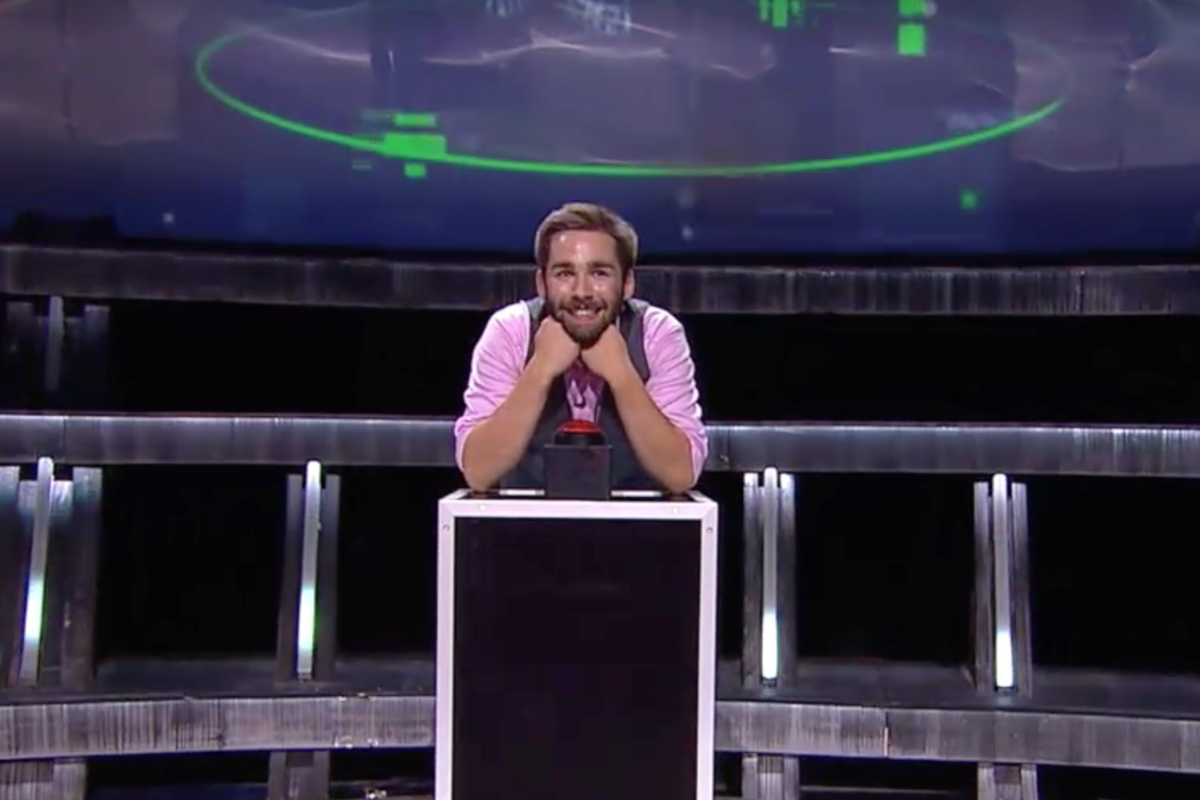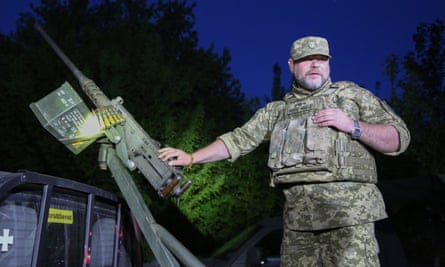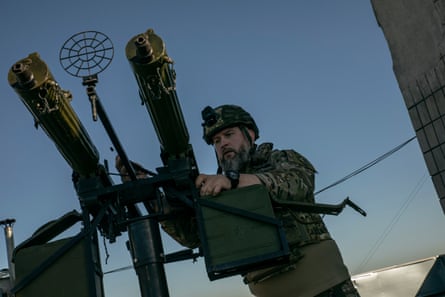Bit of a pallet cleanser, but some lawyers (and judges) in Ukraine behaving bad-ass-ly.
Judges with machine guns: the part-time drone hunters defending Kyiv
Judges with machine guns: the part-time drone hunters defending Kyiv
The ‘Mriya’ unit made up of members of the legal profession patrols the capital region’s skies with antique weapons
Luke Harding in the Kyiv region. Photographs by
Alessio Mamo and Oleg Solokha
Thu 9 May 2024 05.00 BST
In a small wood in the Kyiv region Anatoliy Shyshak stared at the night sky. Dusk was falling. The only sounds came from a thrush nightingale and a faraway yapping dog. Shyshak – a sergeant in Ukraine’s territorial army – was listening for something else: an enemy drone. “It sounds like a moped. Not a classy Italian one, but something cheap and horrible,” he said. “They fly between 100 and 300 metres above the ground. You hear a rattling.”
For the past year Shyshak’s brigade,
the 241st, has scoured the heavens for Russian flying objects. Its task is to shoot them down before they can reach the capital. He and his territorial defence colleagues are based about 100km east of Kyiv, along one of several drone flight paths. “I like my job. We are pretty successful. We stop death here. Our families are in Kyiv so we are protecting our wives and children,” he said.
Since its full-scale invasion in 2022, the Kremlin has launched numerous air attacks across Ukraine, against towns and cities. It uses an array of deadly weapons including kamikaze drones – at least
4,600 of them – and hypersonic ballistic missiles. Last year many were taken out. But in recent months the interception rate has fallen to about 60%, largely because Republicans in the US Congress delayed a $61bn (£49bn) package of military assistance including vital air defences.
Yevhen Dolin, 43, a territorial defence soldier, shows off his jeep-mounted M2 Browning machine gun in the Kyiv region. Photograph: Oleg Solokha/The Guardian
The consequences have been grim. Last week Russia
fired a rocket carrying cluster munitions at the port of Odesa, killing five civilians. A law academy building known as Harry Potter’s castle caught fire. Ukraine’s second city of Kharkiv, only 25 miles from the Russian border,
has been pulverised. Early on Wednesday Russian missiles hit Ukrainian energy facilities in six regions. The Kremlin has used weapons sometimes supplied by foreign partners: Iranian-made Shahed drones and
short-range ballistic missiles from North Korea.
Volodymyr Zelenskiy has repeatedly asked western allies
for modern Patriot air defence systems. Ukraine needs another seven of them to defend its skies, Zelenskiy says, as well as fresh stocks of interceptors. These are used to destroy fast-moving Iskander and Kinzhal missiles, launched from the ground and bomber planes respectively. It is unclear when any further Patriots – from the EU and US – may arrive. Last week Spain and Greece said they would not transfer their own batteries.
In the meantime, Shyshak’s unit hunts slower-flying drones using ancient military equipment that could have come from a museum.
Ukrainian air defence forces shoot down attack drones near Kyiv – video
Yevhen Dolin showed off his machine gun: an M2 Browning, designed during the first world war. “It might be old but it works,” he said. The gun was mounted on the back of a pickup truck. There was no point in wasting a $4m Patriot missile on a $20,000 drone, he explained, observing: “It’s basic economics. You don’t use a big gun to shoot a sparrow.”
The mobile unit also has a couple of Soviet heavy machine guns, known as Dushkas. They are fitted with tracer cartridges and regular rounds. In a training session this week the unit parked its vehicles in a clearing. Two projectors threw light into the darkness, illuminating moths. A commander shouted: “Ready, aim, fire!” The machine gunners opened up. Two lines converged in a flash of red and green. There was smoke and an ear-splitting pop-pop-pop-pop.
Capt Oleksandr Zhygun said his platoon was made up of older soldiers, in their 30s and 40s. He was 38. Most came from civilian life and had worked as TV journalists and designers. Their weapons were middle-aged too. “We are using antiquated guns because we don’t have new ones,” he said wryly, producing his Kalashnikov. The rifle was made in 1989, he noted, the same year the Kremlin’s Red Army left Afghanistan.
Members of the 241st brigade on a training exercise. The soldiers shoot down Russian kamikaze drones as they fly towards the Ukrainian capital. Photograph: Oleg Solokha/The Guardian
Zhygun said so far his team had shot down every drone they had encountered. The Russians had recently changed tactics. Last October they began painting attack drones black, making them harder to spot, he said. Moscow’s unmanned aerial vehicles went on zigzag routes and could be redirected while airborne. They included reconnaissance drones that sought to spot Ukraine’s air defence positions so they could be bombed.
Unit members sleep in an underground dugout. Its roof is made from cross-hatched logs. Were it not for the war, the view would be idyllic: fields and dappled groves, bathed by a coral-pink sunset. With Russian troops advancing in the east, seizing a string of villages near the
city of Avdiivka, could Ukraine still win? “It’s a difficult question. We need more air defence systems. For now we have to ration our bullets. A lot depends on our western partners,” Zhygun said.
The 241st brigade also defends the centre of Kyiv. A machine-gun post has been set up on the 12th floor of a residential apartment block on the edge of the city. Nearby is a thermal power plant. This spring, Russia has relentlessly targeted Ukraine’s energy infrastructure. In April it crippled a neighbouring electricity sub-station, visible in the distance, beyond a forest and the Dnipro River: a pair of chimneys poking through the haze.
Ukrainian forces take part in live-fire air defence exercises east of Kyiv – video
The last major rocket Russian attack on Kyiv took place a month ago, Yevhen Miezientsev said. His Maxim gun – made in 1944 – had downed four drones. It could not hit hypersonic missiles, which can travel at speeds of Mach 10, he explained. Most members of his unit – known as “Mriya” (dream) – are part-time volunteers with jobs in the legal profession. Several times a month he spends 24 hours on lookout duty. The rest of the time he is a judge in the appeals court, based in the capital’s sixth district.
“We don’t have any choice. We have to win this war. If we don’t our children and grandchildren will still be fighting Russians,” he said. “None of us want to live in Putin’s Russia. We want to be free and independent. We don’t want to be our neighbour’s slaves.”
Mykola Misechko, another volunteer judge, said negotiations with Moscow were pointless. “It’s a nonsense. You know a Russian is lying when he moves his mouth,” he said.
Miezientsev with his Maxim heavy machine gun made in 1944. Photograph: Alessio Mamo/The Guardian
Last week no drones could be observed. Two military helicopters clattered above the tower blocks, moving rapidly across a bright blue sky. Otherwise all was calm.
“Putin could try and seize Kyiv again. But we are better prepared than two years ago,” Miezientsev reflected. “When we get F-16s, Patriots and other modern weapons the situation may change. We need more of them. At the moment we don’t have a possibility to advance.”

www.vancouverisawesome.com
www.lawsociety.bc.ca









